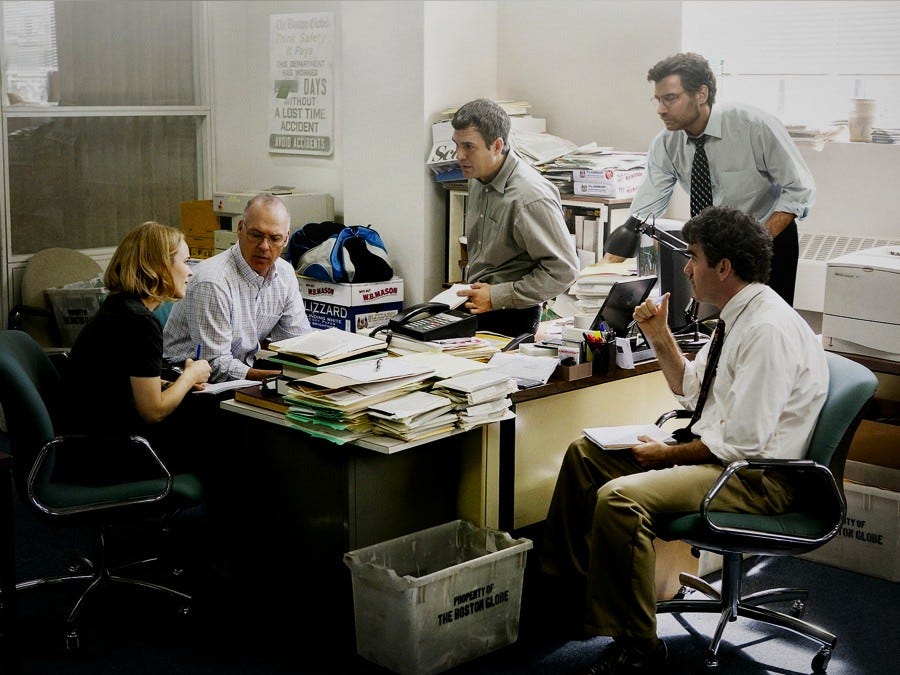
Nigh on ten years ago I watched this Oscar winning beauty at my local cinema and a decade on Spotlight still shines a pertinent and pun intended bright light on the underbelly of a world the majority refuse to believe exists or would rather remain in blissful, distracted ignorance of. That’s nothing new and nor are the despicably evil and heinous crimes catalogued here in a “Based on Actual Events” movie that garnered six Oscar nominations and two wins (Best Picture and Best Original Screenplay) at the 88th Academy Awards in 2016, an astonishing 69 wins from a worldwide total of 134 nominations, yet the omission of Howard Shore’s beautiful music soundtrack from any major awards recognition continues to defeat reason. Whilst Michael Keaton, Liev Schreiber, John Slattery, Stanley Tucci and Billy Crudup all drive the story from disparate tangential perspectives into the centre ground of a film many have likened to 1976’s All The President’s Men (but which I saw larger echoes in the contemporary films of David Fincher’s Zodiac in 2007 and Steven Spielberg’s The Post a decade later), your stars of the show and the real heartbeat of the film resides in the eager and overly enthusiastic determination of a performance from Mark Ruffalo and the smiling empathy and human contradictions writ large in Rachel McAdams portrayal. There’s a collective effort of old fashioned journalism: the knocking of doors, the collection of evidence, the scanning of a microfiche, the manual thumbing through of church records and directories, the chasing of leads, the heartbreaking interviews conducted of survivors who have told their story time and time again only to see their lives of abuse relegated to a minor paragraph of a story long forgotten.
But no longer.
The beauty of Tom McCarthy’s film (and an Oscar win he shared with Josh Singer for Best Original Screenplay) is the methodical and clear story it wishes to tell. Mark Ruffalo’s oft shown angry outburst at his determination and eagerness to run the story and run it now aside, there’s no further grandstanding or need to over emphasize or complicate an albeit horrific tale. The passion for the investigation is carried on the weight of the shoulders of Michael Keaton’s performance and within an ensemble cast amid level headed conversational discourse against the background of an enveloping silence of a local community entrusting their children to the very pillar of their familial existence. Past stories have been told, repeatedly, lives lost or destroyed to other forms of abuse as Priests have been reassigned to other Parishes or constantly on “Sick Leave”, “Absent on Leave” or “Unassigned” as stories and rumours are buried within a net of silence.
That’s enough from me.
Here are the opening 13 minutes, a description of the final frames of the film and a recommendation to view this Oscar winner sometime.
Howard Shore’s beautiful piano led soundtrack commences the film and accompanies the film’s sparse opening credits and a simple white on black acknowledgement of “Based on Actual Events” as we quickly cut to a police officer walking through the corridors of Boston’s District 11 Police Station and “Boston, MA — 1976” as the scene is quickly set: Unseen in a side room is a distressed mother and a story of the abuse suffered by her children at the hands of a local Priest. A Boston District Attorney arrives quickly and whilst hurriedly walking to the room requests both the senior and junior officers on duty to keep quiet on the incident with no leak of the details to the local papers. The younger of the two officers scoffs in his now absence as to how the details won’t leak to the papers following the arraignment and court proceedings.
The senior officer deadpans “What arraignment?”
As the District Attorney enters the room a Priest can be partially seen but mostly heard, assuring the mother of the “good work the church does in the community” as well as confirming the abuse suffered by her children will never happen again and the Priest involved will be moved to another Parish. We cut from the children silently drawing and colouring on pieces of paper to two Priests hurriedly making their exit from the Police Station and into a dark and cold Boston night and quickly driving away through the snow covered streets as “SPOTLIGHT” is shown in white on black in the centre of the screen.
A quarter of a century later in July 2001 we now join a lively and laughter filled leaving party in the Boston Globe offices and all of our main newspaper characters and portrayals bar one. Firstly, we have “Ben Bradlee” (John Slattery) before he quickly passes the celebratory leaving party baton to “Walter Robinson” (Michael Keaton) and as we discover equally quickly that he’s more commonly known as simply “Robby”, McCarthy’s camera picks out two of the smiling faces of his four person team, namely “Sacha Pfeiffer” (Rachel McAdams) and “Matt Carroll” (Brian d’Arcy James). McCarthy’s camera is again to the fore as we now follow Sacha and Matt (party cake in hand) through the winding corridors of the newspaper office and back to their own small and cramped Spotlight office and a constantly busy “Michael Rezendes” (Mark Ruffalo) chasing a story on the telephone. Over cake, all three discuss the suitability or otherwise of Michael’s current story and with Robby returning, the conversation soon turns to the newly arriving editor-in-chief, a man from Miami with zero knowledge of Boston, how their newspaper is run and a man renowned in the industry for instant cuts to the workforce. “Hey Robby” shouts Michael, “New boss coming in to make some cuts?”. Among other Spotlight issues he confirms he simply doesn’t know but he has a “sit down” with him soon.
We cut to that sit down immediately and later in the evening at a busy restaurant as “Marty Baron” (Liev Schreiber) is seen reading “The Curse of the Bambino” as he readily admits to Robby immediately on meeting him that he needs to get a “feel” for the city. Cordial yet cold, he also admits to being nonplussed by The Globe having season tickets at Boston’s Fenway Park and after jotting copious notes in his notebook (to which he refers to repeatedly in the film), he turns the conversation over to Robby a “born and raised” Bostonian, a fact he relays with huge pride as well as confirming the vast majority of the newsroom are from the city too, ensuring the newspaper has the feel of a “local paper”. Asked to explain his role, Robby self-deprecatingly shies away from describing himself as an editor and more a “player coach” of a 4 person investigative team dealing in strictly confidential stories that often take months or even years to fully materialise and come to print. McCarthy excels here again with a simple two camera shoot, one on each man, as Marty begins to warm to the conversation and whilst surprised Robby’s team take so long in producing a single story, he explains that from his early analysis that readership is down and with the internet cutting into both this readership and the larger revenues of the paper’s classified business, he’s been brought in to “take a hard look at things” and with staff cuts inevitable, he wants to ensure the paper is “essential to its readers”. Robby contends that it is.
Marty responds with a simple “We can do better”.
Daytime now and an overhead shot outside of the parking lot of The Globe and quickly inside to Ben and Robby chatting conspiratorially on their way to an editorial meeting with a man Robby “couldn’t get a read on” and Ben tersely describes sarcastically as a “barrel of laughs”. A round table meeting of editors is headed by the new editor-in-chief and after brief discussions of the current stories within their Metro and Sports sections, Marty raises the abuse story highlighted within the column of “Eileen McNamara” (Maureen Keiller) with Eileen found by McCarthy’s camera on the periphery of the circle and not within its inner sanctum. Eileen’s story of a Boston Priest accused of abusing 80 local children is clearly Marty’s top priority, but not of Ben Bradlee who assures him the story, and others like it, have been printed in the recent past. Marty counters that the paper has “written all of, uh, two stories in the past six months” and that whilst the court documents are sealed, it’s essential a local paper requests access to them. Bradlee immediately states that the church will see this as the paper suing them if a request is made to the court to unseal the documents.
Without missing a beat, Marty responds “Good to know”.
Immediate cut to Ben Bradlee’s office and with Michael Rezendes soon joining Robby and unable to hide his glee that they’re possibly expanding Eileen’s story to a much wider investigation, Ben’s telephone rings and both he and Robby are requested in his Marty’s office immediately. Continuing where he left the larger editors meeting, Marty is more than keen to indeed expand the investigation with Ben immediately countering that he and his team of editors across many facets of the newspaper have dealt with this story in the past. Marty, looking at Robby, insists the story needs a much deeper investigation and speaking on behalf of his colleague and from a senior position too, Ben states proudly that “Spotlight has had success in the past in large part by picking their own projects”.
Looking directly at Robby once more, Marty asks “Would you consider picking this one?”.
The film’s closing frames:
“Over the course of 2002, the Spotlight team published close to 600 stories about the scandal”
“249 Priests and Brothers were publicly accused of sexual abuse within the Boston Archdiocese”
“The number of survivors in Boston is estimated to be well over 1,000”
In December 2002, Cardinal Law resigned from the Boston Archdiocese. He was reassigned to the Basilica di Santa Maria Maggiore in Rome, one of the highest ranking Roman Catholic churches in the world”
“Major abuse scandals have been uncovered in the following places…”
The film closes with 4 full screen lists of 105 American towns and cities and 101 cities and towns worldwide.
Thanks for reading. I hope this message in a bottle in The Matrix finds you well, prospering, and the right way up in an upside down world.
Whilst you’re here I may as well brag about the release of my trilogy of recently self-published books. Beautiful covers eh! As the title(s) would suggest, this is my life at the movies or at least from 1980 to 2024, and in volume 1 you’ll find 80 spoiler free appraisals of movies from debut filmmakers, 91 of the very best films appraised with love and absent of spoilers from 1990–2024 in volume 2, and in volume 3 you’ll find career “specials” on Paul Thomas Anderson and Quentin Tarantino together with the very best of the rest and another 87 spoiler free film reviews from 2001–2024.
All available in hardback and paperback and here are some handy links:
"A Life at the Movies Vol.1" - link to Amazon
"A Life at the Movies Vol.2" - link to Amazon
"A Life at the Movies Vol.3" - link to Amazon





